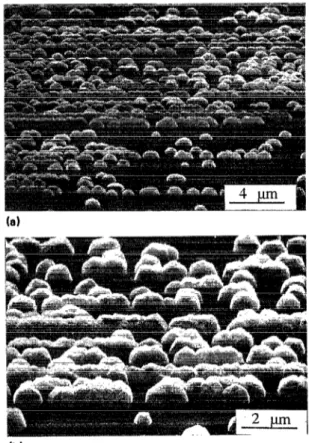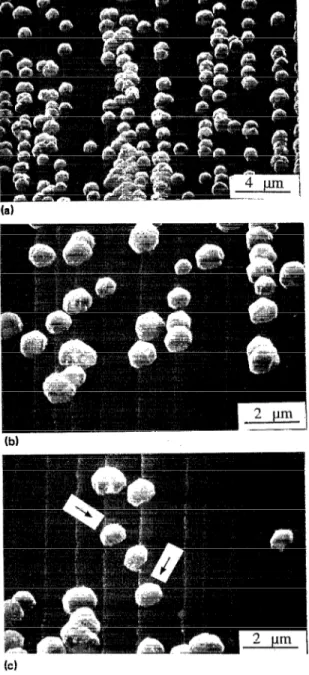Diamond nucleation on cleaved Si((l11)
Riccardo Polini
Dipartimento di Scienze e Tecnologie Chimiche, Universitb di Roma “Tar Vergata” Via Orazio Raimondo, 00173 Roma, Italy
(Received 26 March 1992; accepted for publication 9 June 1992)
Diamond crystallites have been nucleated and grown by hot filament chemical vapor deposition at 600 “C! on the untreated fracture surface of a cleaved Si( 111) sample. The flat surface of the cleaved crystal was inactive towards diamond nucleation while, on the terraced surface formed by the propagating crack, a high density of nuclei was found. The crystallites were nucleated.in correspondence of edges between ( 111) terrace planes and step planes. The occurrence of edges, as determined by scanning electron microscopy (SEM) observation, is a necessary but not sufficient condition for the nucleation and this fact suggests that particular atomic arrangements are required for the diamond nucleus formation.
The role of substrate pretreatment in enhancing the nucleation density in the diamond deposition from the gas phase is still unclear. In fact, the effect of surface scratch- ing by abrasive powders is currently a matter of debate, as well as the role of carburization reactions occurring at the surface of carbide former substrates. Several authors claim the presence of seeds in explaining the enhanced nucleation on substrates as different from metals, silicon, or glass which are submitted to scratching by diamond paste or to ultrasonic activation with diamond powder suspension.’ The previous deposition of amorphous hydrogenated car- bon (a-C:H) has been demonstrated to be effective in en- hancing the nucleation density of diamond, but to a limited extent only.223
In a recent paper, Dennig and Stevenson4 reported that the nucleation of diamond from the gas phase in the hot filament assisted chemical vapor deposition (HFCVD) may occur on locations that protrude from the surface, such as edges or apexes. They reported that the diamond nucleation on unscratched silicon substrates is independent of the way the surface topographical patterns were pro- duced. In the case of molibdenum substrates abraded with diamond paste prior to the deposition process, the authors found that on scratches having round-shaped edges, the diamond nucleation did not occur. These authors stated “although residual diamond abrasive powder may enhance nucleation, our results show that nucleation is promoted by topographical features alone . . . the presence of some residual abrasive is not necessary to initiate nucleation.”
The results reported in this communication partly sup- port those findings and confirm that seeding is not the only way to explain the increased nucleation density on sub- strates submitted to scratching with diamond paste.
Diamond crystallites have been deposited by tantalum HFCVD on a Si ( 111) crystal cleaved in air with chisel and hammer. Due to the exposure to atmosphere, the resulting Si surface is expected to be covered by a layer of native oxide, SiO, (x <2), whose thickness is in the range of 12-30 A5 and by several monolayers of water, weakly bound, that desorb at temperatures higher than 200 ‘CL6
The specimen was washed by acetone in an ultrasonic
vessel and then inserted in the deposition chamber,7 with- out any abrading treatment.
The deposition process was carried out according to experimental conditions that ensure the formation of the diamond phase only8 (2.0% v/v CH, in Hz, total flow rate 100 seem, P= 76 Torr, filament temperature = 2 180 “C, and substrate temperature = 600 “C) . Substrate to filament dis- tance was 6 m m and the deposition time 1 h.
Following the deposition process, the sample was ob- served by SEM. The microscopic observation showed that the fracture surface was a flat plane except near the notch, where many cleavage steps were present. The steps visible
(b)
FIG. 1. Nucleation of diamond on the Si( 111) terraced surface produced by cleavage: (a) top view of the decorated “staircase,” (b) particular view of diamond crystallitea (tilt= 55’).
2517 J. Appl. Phys. 72 (6), 15 September 1992 0021-8979/92/182517-03$04.00 $I 1992 American Institute of Physics 2517 Downloaded 13 Sep 2005 to 160.80.30.238. Redistribution subject to AIP license or copyright, see http://jap.aip.org/jap/copyright.jsp
la)
(bl
FIG. 2. Lateral view of the terraces: picture (a) represents a general view; in (b) the edge nucleation is shown; the crystals indicated by an arrow in picture (c) were nucleated on edges formed by a substep and the terrace..
on a cleaved surface may arise for several reasons. They may result from the intersection of a cleavage crack with a low-angle boundary containing a grid of closely spaced screw dislocations, all of the same sign.g In that case large- sized steps, observable by an optical microscope, develop in the cleavage plane giving rise, at the low-angle boundary, to characteristic river patterns. Another possibility is sim- ply due to the fact that, in the case of specimens fractured by a hammer and a chisel, if the cleavage crack starts in such a manner that the crack is not parallel to the cleavage plane, the steps are formed in such a way to accomodate the misalignment. The latter mechanism is probably the most effective in the present case.
On the flat surface of the sample, no diamond nucle-
ation was observed. On the contrary, on the stepped sur- FIG. 4. Terraced region of the surface where inhomogeneous nucleation occurred. FIG. 3. SEM picture of (111) terraces (lighter planes) and steps (darker planes); the different contrast is due to the fact that the secondary elec- tron yield is proportional to l/cos& where 0 is the angle between the primary electron beam and the normal to the surface
face, a conspicuous diamond nucleation occurred (up to 107-lo8 nuclei/cm’). Nucleation behavior is visible in Figs. l(a) and l(b) where the top view of the diamond- decorated “staircase” is shown. Figures 2(a) and 2(b) show that the steps are about 1 pm wide and that diamond crystallites nucleate in correspondence of edges. No nucle- ation has been observed on Si( 111) terraces. In Fig. 2(c), the crystals marked by arrows were nucleated in corre- spondence of substeps present on terraces.
Several diamond crystals exhibit well-defined flat (100) faces and the analysis of their layout does not show any preferred crystallographic orientation with respect to the silicon substrate.
The edge nucleation is more evident in Fig. 3, where a different tilting of the sample allows one to confirm the above mentioned findings. In this micrograph, the lighter terraces correspond to ( 111) planes. The darker planes indicate that the height of the steps is of the same order of magnitude as the terrace length.
The stepped surface produced during the cleavage pro- cess presents features similar to those prepared by topog- raphy patterning techniques4 but, as shown in Fig. 4, the presence of edges is a necessary but not sufficient condition
2518 J. Appl. Phys., Vol. 72, No. 6, 15 September 1992 Riccardo Polini 2518
for diamond nucleation in that on several stepped zones, no diamond nucleation has occurred. The rationalization of this fact requires further investigations in order to de- termine the particular atomic arrangements at the edges. In fact, the step-edge geometry depends on the crystallo- graphic direction of the edge itself. l”*l ’ This [UVW] dir&ion is determined by what kind of (hkl) plane interesects the
(111) terrace plane (in fact: u=Z-k, v=h-Z, w=k-h) and by the presence or absence of kinks.
In conclusion, the present communication shows that high nucleation densities can be obtained on silicon sub- strates without the need of seeding by diamond powder. These results confirm the findings reported by Dennig and Stevenson4 and, in particular, show that Si( 111) terraced surfaces present edge structures suitable for diamond nu- cleation.
The author is very grateful to Elettronica S.p.A. and to Istituto di Struttura della Materia (ISM-Consiglio Nazio- nale delle Ricerche) for the access to their SEM facilities
and to Professor E. Molinari and Dr. M. Tomellini for helpful discussions.
‘S. Iijima, Y. Aikawa, and K. Baba, J. Mater. Res. 6, 1491 (1991). *K. V. Ravi and C. A. Koch, Appl. Phys. Lett. 57, 348 ( 1990). 3 .I. J. Dubray, C. G. Pantano, M. Meloncelli, and E. Bertran, J. Vat. Sci.
Technol. A 9, 3012 (1991).
4P. A. Dennig and D. A. Stevenson, Appl. Phys. Lett. 59, 1562 (1991). ‘A. H. Al-Bayati, K. G. Orrman-Rossiter, J. A. van den Berg, and D. G.
Armour, Surf. Sci. 241, 91 (1991), and references therein.
6K. H. Besocke, M. Teske, and J. Frohn, J. Vat. Sci. Technol. A 6,408 (1988), and references therein.
‘E. Molinari, R. Polini, M. L. Terranova, P. Ascarelli, and S. Fontana, J. Mater. Res. (in press).
*P. Ascarelli, E. Molinari, R. Polini, V. Sessa, M. L. Terranova, I?. Cappelli, and S. Fontana, Proceedings of the NATO-AS on Diamond and Diamondlike Films and Cbatings, edited by B. Clausing, J. Angus, P. Koidl, and L. Horton (Plenum, New York, 1991).
9J. J. Gilman, Trans. AIME 212, 310 (1958).
‘OR. J. Phaneuf, E. D. Williams, and N. C. Bartelt, Phys. Rev. B 38, 1984
(1988).
“D. Dijkkamp, E. J. van Loenen, A. J. Hoeven, and I. Dieleman, J. Vat. Sci. Technol. A 8, 218 ( 1990).
2519 J. Appl. Phys., Vol. 72, No. 6, 15 September 1992 Riccardo Polini 2519

